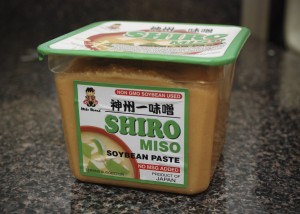Rebekah Facteau is my new virtual intern. She is a senior dietetic student from New York and will be writing blog posts on a regular basis. See below for more about Rebekah.
by Rebekah Facteau
 Miso soup is the perfect food to warm the body, and satisfy the soul during these colder winter months. Now a Japanese staple, miso actually originated in China, but found its way to Japan sometime in the 7th century. At that time it was only consumed by the most elite, but today it’s common for anyone to sip everyday. Miso found its way around the world and gained popularity in the Western hemisphere sometime around the 1960s.
Miso soup is the perfect food to warm the body, and satisfy the soul during these colder winter months. Now a Japanese staple, miso actually originated in China, but found its way to Japan sometime in the 7th century. At that time it was only consumed by the most elite, but today it’s common for anyone to sip everyday. Miso found its way around the world and gained popularity in the Western hemisphere sometime around the 1960s.
Miso can be used for much more than just that wonderfully flavorful soup. It’s a product of a lengthy fermentation process, in which steamed grains, typically rice or barley but in some cases soybeans, are combined with the mold Aspergillus oryzae to make koji. Koji serves as the enzymes, and the “starter” to activate fermentation. The koji is then mixed with cooked soybeans, water, and salt and transferred into large vats or barrels. It’s a similar process to winemaking and this adds flavor to the final product. The miso is left to ferment anywhere from a few weeks to several years. The resulting product is a paste that can be used in soups, sauces, dressings, or even as a dairy substitute. To use miso as a dairy substitute, choose only shiro, or mellow white, miso to use instead of creamy items in cooking.
There are several varieties of miso, each with their own unique color, and flavor. Here are a few of the most common:
- Hatcho miso, made only from soybeans, is the darkest and richest flavored. Hatcho is best used for hearty soups, and sauces.
- Kome-miso, made from white or brown rice with soybeans, is light beige in color, and slightly sweet. Kome-miso is best for dressings, or dairy substitutes.
- Mugi-miso, made from barley and soybeans, ranges from golden to reddish brown, with the flavor varying accordingly, but is typically described to have an earthy taste. Mugi-miso is considered an “all-purpose” miso.
- Shiro miso, made from rice and soybeans, is the lighter in color, and sweet to taste. This is also lower in sodium than other varieties.
Unless you’re a miso expert, keeping any of the above on hand should adequately cover your miso needs. The most important thing to remember is that like yogurt miso is a living food. It contains beneficial enzymes and bacteria, and should therefore always be kept in the fridge. Watch out for pasteurized versions that will no longer contain the good bacteria, and always check the label for too many additives. The ingredients should be simple. More importantly, if you ever see miso as a dry mix, packaged in an envelope, put it back right where you found it. These will only mimic the flavors, and fill you up with sodium, and MSG. (JN,TVQ: I was just given a sample of freeze-dried miso powder from Japan that supposedly has live bacterial activity. I have not yet tried it so cannot comment. Be sure to read labels.)
On that note, miso does naturally contain a high amount of sodium due to the fermentation process, so it’s best to do as the Japanese do and enjoy it in small servings. A few other areas of interest for health conscious, and plant-based eaters—quality miso might be a source of Vitamin B12. It’s fermented with a B12 synthesizing bacteria, and has been commonly recommended for vegans. Miso can also provide you with trace minerals such as zinc, manganese, and copper.
 It’s hard to say whether or not your local Japanese joint is giving you the good stuff. It’s likely that they’re using pasteurized, or “quick” varieties due to the volume that they sell. Making your own miso paste could take years, but luckily making your own soup will only take minutes. Here’s a simple recipe from Mark Bittman, The New York Times lead food writer.
It’s hard to say whether or not your local Japanese joint is giving you the good stuff. It’s likely that they’re using pasteurized, or “quick” varieties due to the volume that they sell. Making your own miso paste could take years, but luckily making your own soup will only take minutes. Here’s a simple recipe from Mark Bittman, The New York Times lead food writer.
1 quart water
1/3 cup hatcho or other miso
8 ounces silken tofu, cut into ½” cubes
¼ cup minced scallion
- In a medium saucepan, heat the water until steaming (do not boil). Turn the heat to low, and mix about ½ cup of the liquid and miso in a bowl or blender until smooth.
- Pour the miso mixture into the hot water and add the tofu; stir once or twice and let sit for a minute, just long enough to heat the tofu through. Add the scallion and serve.
Bittman also suggests adding other ingredients such as seaweed, sliced shiitake mushroom caps, or a garnish of grated ginger.
To see another way that I use miso check out my recipe for
For more information on miso, you can read this recently published article from Grant Butler of The Oregonian by clicking here.
 About Rebekah Facteau
About Rebekah Facteau
“I’m a second-degree student, studying Food and Nutrition at Brooklyn College in New York. I hail from the Adirondacks in upstate NY, but have lived in New York City for four years. My first degree was a Bachelors of Fine Arts, causing me to naturally gravitate towards the more creative areas of the nutrition field, such as cooking and writing.
When I was growing up, dinner was always served at 5:30. The whole family gathered around the table to share stories about our day. The bonds between us grew and strengthened over home cooked meals, making food central to my life and the person I’ve become. Along with my shift in career plans, our family’s idea of good food dramatically changed with personal diagnoses, inspiring me to pursue a career in Dietetics where I hope to motivate people to take control of their own health in their kitchen rather than their doctor’s office.”
You can read more of Rebekah’s writing at veggiepro.wordpress.com.


Leila,
You are correct about not boiling the miso. If it is slightly heated, it is OK. I do love my niso in dressings and dips and stirred into my rice and other grains and much more.
Miso enriches the flavors in soups and stews, too. I like to add it to individual portions so reheating doesn’t destroy the good bacteria. Yum.
Thanks for the added information, Jill. As I say, I haven’t given up on using miso. I just need to pay attention to where any additional salt may be coming from if I add it to something that already has salt. And it’s certainly easy enough to substitute miso for salt in many recipes.
Hi, I’m confused about miso being a good source of probiotics. It must only apply to uncooked food like dressings or dips as the heat from being in a soup or stew would kill any bacteria – no?
Sigrid,
Yes, miso does contain sodium from the fermentation process, yet everything that I have read about it seems to indicate that the sodium from fermented foods does not have as much effect on blood pressure as the sodium from processed foods. Perhaps it is due to using miso less often and in smaller amounts.
In addition to making miso soup, I also like to add a little miso to hearty, regular soups and stews, just at the end of cooking. I use miso instead of adding any salt.
Since my broth is free of added salt, the miso adds some sodium but likely far less than I’d get from using canned or boxed stock.
I also make a miso sauce with tahini, garlic and lemon. You can add miso when making dips and salad dressings.
Fermented foods such as miso provide good bacteria so don’t look at it just as a shot of sodium but as a tasty way to get probiotics.
Thanks Jill and Rebecca. I’m one of the people who has been bugging Jill to talk about miso. She convinced me that miso was wonderful and now I have a refrigerator full of it with little idea of what to do with it.
Miso soup is easy and would be good if it weren’t for the high salt content. Both my housemate and I are trying to be very careful about adding salt to what we cook and it’s impossible to use miso without getting a considerable amount of sodium. But I haven’t given up!